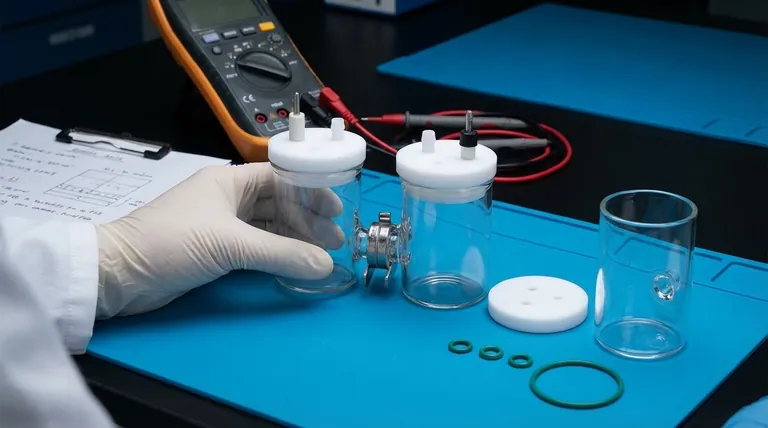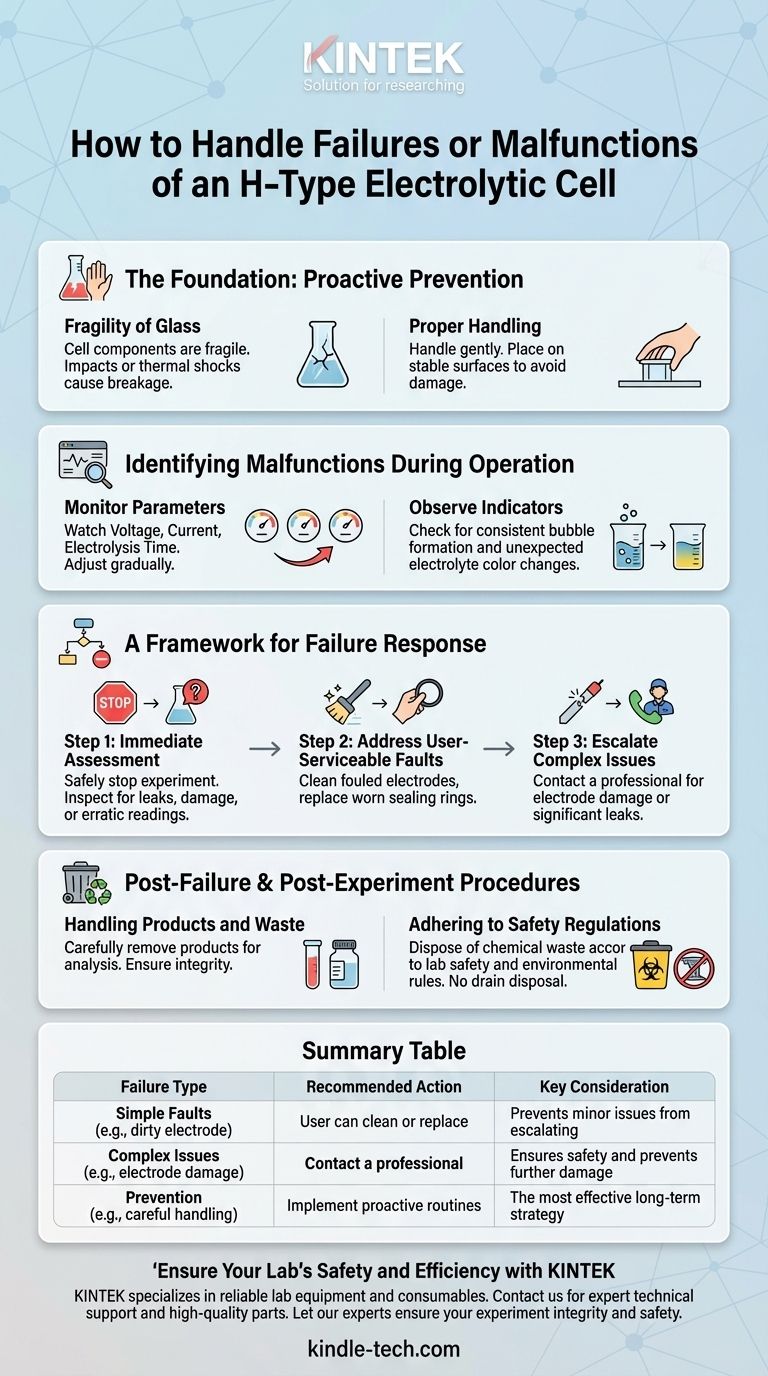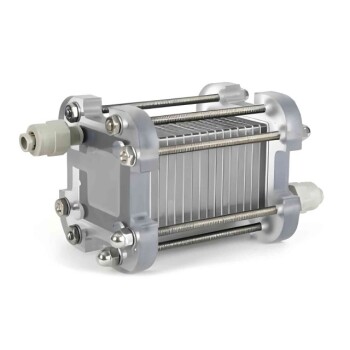When an H-type electrolytic cell malfunctions, your immediate response depends on the complexity of the issue. Simple faults, such as cleaning a dirty electrode or replacing a sealing ring, can often be handled directly by the user. However, for more significant problems like electrode damage or electrolyte leakage, you must contact a professional for repair to ensure safety and prevent further damage.
The core principle for handling H-type cell failures is not just repair, but a comprehensive approach that prioritizes prevention through careful handling, diligent monitoring during operation, and a clear protocol for distinguishing between user-serviceable issues and those requiring expert intervention.

The Foundation: Proactive Prevention
The most effective way to handle a failure is to prevent it from happening. Given that H-type cells are predominantly made of glass, careful handling is the absolute first line of defense.
The Fragility of Glass
The cell body and its components are fragile. Any impact, drop, or significant thermal shock can lead to cracks or complete breakage, compromising your experiment and creating a safety hazard.
Proper Handling Technique
Always handle the glass components gently and deliberately. When moving or setting down the cell, do so slowly and on a stable, clear surface to minimize the risk of accidental damage.
Identifying Malfunctions During an Experiment
Active monitoring during operation is critical for catching problems before they escalate. A deviation from expected behavior is your first sign that something is wrong.
Monitor Experimental Parameters
Keep a close watch on key parameters like voltage, current, and electrolysis time. Adjust these settings gradually, not abruptly, and note any unexpected fluctuations.
Observe Physical Indicators
Pay attention to the physical processes within the cell. Look for consistent bubble formation on the electrode surfaces and any unexpected color changes in the electrolyte. A lack of bubbles or a sudden change in appearance can indicate an issue with the electrode or a reaction.
A Framework for Failure Response
When you suspect a malfunction, a structured response is essential for safety and efficiency.
Step 1: Immediate Assessment
First, safely stop the experiment. Then, carefully inspect the cell for the source of the problem. Is there a visible leak? Is an electrode clearly damaged? Are the readings completely off?
Step 2: Address User-Serviceable Faults
Simple issues can often be resolved without professional help. These typically include tasks like cleaning a fouled electrode or replacing a worn sealing ring that may be causing a minor leak.
Step 3: Escalate Complex Issues
Do not attempt complex repairs yourself. If you identify physical damage to an electrode, a significant electrolyte leak, or a malfunction you cannot diagnose, contact a professional repair technician immediately.
Post-Failure and Post-Experiment Procedures
Proper cleanup is a critical part of the process, whether an experiment concludes successfully or is halted by a failure.
Handling Products and Waste
After the process, carefully remove the experimental products and waste liquid. Ensure any products requiring further analysis are stored correctly to maintain their integrity.
Adhering to Safety Regulations
The waste liquid must be disposed of according to established laboratory safety and environmental protection regulations. Never pour untreated chemical waste down the drain, as this can cause environmental pollution.
Making the Right Choice for Your Lab
Your response to any issue should be guided by a clear assessment of the problem and your own level of expertise.
- If your primary focus is immediate repair of a minor issue: Address simple faults like cleaning electrodes or replacing seals yourself, provided you are confident in the procedure.
- If your primary focus is safety and equipment integrity: For any sign of physical damage or complex electrical faults, always halt the experiment and contact a professional.
- If your primary focus is long-term reliability: Implement a routine of careful handling and diligent in-experiment monitoring to prevent failures from occurring in the first place.
By adopting a proactive and methodical approach, you ensure the safety of your lab and the integrity of your experimental results.
Summary Table:
| Failure Type | Recommended Action | Key Consideration |
|---|---|---|
| Simple Faults (e.g., dirty electrode, worn seal) | User can clean or replace | Prevents minor issues from escalating |
| Complex Issues (e.g., electrode damage, electrolyte leak) | Contact a professional immediately | Ensures safety and prevents further damage |
| Prevention (e.g., careful handling, active monitoring) | Implement proactive routines | The most effective long-term strategy |
Ensure Your Lab's Safety and Efficiency with KINTEK
Handling sensitive equipment like H-type electrolytic cells requires precision and the right tools. Don't let a malfunction compromise your research or safety protocols.
KINTEK specializes in providing reliable lab equipment and consumables for all your electrochemical needs. From high-quality replacement parts to expert technical support, we are your trusted partner in maintaining peak laboratory performance.
Contact us today to discuss your specific requirements, and let our experts help you ensure the integrity of your experiments and the safety of your lab.
Get in touch with our team now to find the perfect solution for your laboratory.
Visual Guide

Related Products
- H Type Electrolytic Cell Triple Electrochemical Cell
- H-Type Double-Layer Optical Electrolytic Electrochemical Cell with Water Bath
- Electrolytic Electrochemical Cell with Five-Port
- Double Layer Five-Port Water Bath Electrolytic Electrochemical Cell
- Electrolytic Electrochemical Cell for Coating Evaluation
People Also Ask
- What are the standard opening specifications for an H-type exchangeable membrane electrolytic cell? Asymmetrical Ports for Precise Electrochemistry
- What are the common types of acrylic electrolytic cells? Choose the Right Cell for Your Electrochemical Experiment
- What is the overall structure of the H-type double-layer optical water bath electrolytic cell? Precision Design for Controlled Experiments
- What is the function of an H-type exchangeable membrane electrolytic cell? Master Precise Reaction Control
- What are the specifications of the openings on the electrolytic cell? A Guide to Port Sizes and Configurations



















